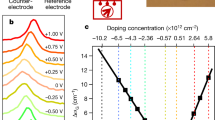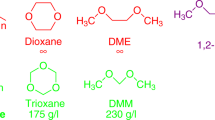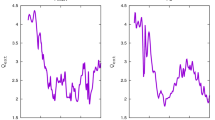Abstract
THE influence of interphasial polarization processes on the dielectric behaviour of aqueous dispersions has been frequently discussed. In earlier communications1,2, I directed attention to a striking effect of such a process, consisting of an extremely pronounced and broad dispersion region in the low-frequency zone, characterized by a rise in permittivity of the order of 100,000 under maximal conditions. The exact nature of this process has not yet been established. It was thought that the sorbed water might exhibit co-operative orientation, although this remains questionable in the absence of theoretical support. While this work was mainly on coarser systems, it was pointed out that the effect is an important factor in the dispersion found in systems of colloidal and macromolecular structure3, a particular study2 being made of gelatin gels in support of this view. This work has now been extended to nitrocellulose gels, in which we have found a strongly developed low-frequency dispersion region, presumably of this same nature. The gels were measured in the form of membranes placed in aqueous solution, a procedure which has certain distinct experimental advantages.
This is a preview of subscription content, access via your institution
Access options
Subscribe to this journal
Receive 51 print issues and online access
$199.00 per year
only $3.90 per issue
Buy this article
- Purchase on Springer Link
- Instant access to full article PDF
Prices may be subject to local taxes which are calculated during checkout
Similar content being viewed by others
References
Fricke, H., and Curtis, H. J., J. Phys. Coll. Chem., 41, 729 (1937).
Fricke, H., and Parker, E., J. Phys. Coll. Chem., 44, 221 (1940).
Errera, J., J. Phys. et le Rad., 4, 225 (1923). Murphy, E. J., and Lowry, H. H., J. Phys. Coll. Chem., 34, 598 (1930). Fricke, R., and Havestadt, L., Z. inorg. Chem., 188, 357 (1930); 196, 120 (1931). Fricke, R., Koll. Z., 56, 166 (1931). Haller, W., Koll. Z., 56, 170 (1931). Nanty, N., and Valet, M., C.R. Acad. Sci., Paris, 194, 883 (1932). Tausz, J., and Rumm, H., Koll. Beih., 39, 58 (1933). Kruyt, H. R., and Kunst, H., Koll. Z., 91, 1 (1940). Mizuno, S., Toshima, S., and Shiratori, H., J. Electrochem. Soc., Japan, 18, 301 (1950).
Weech, A. A., and Michaelis, L., J. Gen. Physiol., 12, 221 (1928–29).
Bjerrum, N., and Manegold, E., Koll. Z., 43, 5 (1927). Hitchcock, D. I., J. Gen. Physiol., 9, 755 (1925–26).
Author information
Authors and Affiliations
Rights and permissions
About this article
Cite this article
FRICKE, H. Dielectric Properties of Nitrocellulose - Water Gels. Nature 172, 1106–1107 (1953). https://doi.org/10.1038/1721106a0
Issue Date:
DOI: https://doi.org/10.1038/1721106a0
Comments
By submitting a comment you agree to abide by our Terms and Community Guidelines. If you find something abusive or that does not comply with our terms or guidelines please flag it as inappropriate.



